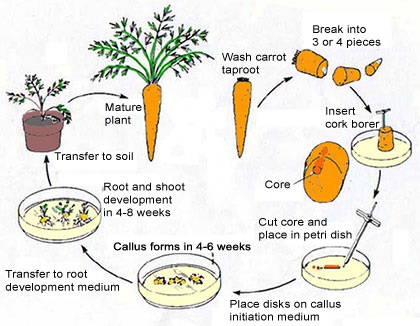
- Plant tissue culture is an in-vitro culture or growth of cells, tissues or organs of plant in a sterile condition and well formulated media to produce an entire plant.
- The term “tissue culture” is used in a very wide sense.
- German botanist G. Haberlandt is regarded as the father of tissue culture.
- It is an important technique for the production of disease free and high quality plants within a short period of time.
Basic steps involved in plant tissue culture:
- Preparation of suitable nutrient medium:
- MS medium, White’s medium, B5 medium are few culture media that can be obtained from the market for the lab preparation of nutrient medium needed for tissue culture.
- The culture medium consists of :
Inorganic nutrients:
- 2 types of inorganic nutrients are used in the culture medium.
- 6 macronutrients like nitrogen, phosphorus, sulphur, calcium, potassium and magnesium and 6 micronutrients like iron, molybdenum, copper, zinc, boron and manganese are also added in the medium.
Organic nutrients:
- Carbon and nitrogen containing compounds are used.
- Sucrose, fructose and other carbohydrates are the carbon source.
- Vitamins and amino acids are the nitrogen source.
- Vitamins: Thiamine is an essential vitamin whereas inositol, pyridoxin, nicotinic acid, pantothenic acid etc. are promontory vitamins.
Plant growth hormones : Auxins, Gibberellins, Cytokinins, Abscisic acid, Ethylene etc. are some examples of plant hormones. Auxins, cytokinins and Gibberellins are the most commonly used growth hormones in culture medium prepared for tissue culture.
Agar : It solidifies the medium and acts as a substratum. It doesn’t have any nutritive importance. It is obtained from sea weeds and is used to provide solid surface for growth.
- All these important nutrients are incorporated in the culture medium and transferred into suitable containers and then sterilized.
- Selection of explant:
- Explants are any excised part of the plant to be used in tissue culture like axillary buds, leaf and stem segments, root tip, shoot tip, anther, ovary and endosperm.
- Always young and healthy parts of plants are selected as explants.
- Sterilization of the explant:
- Explants are sterilized by using different types of disinfectants like sodium hypochlorite (2%), silver nitrate (1%) calcium hypochlorite (9-10%), bromine water (1-2%), mercuric chloride (0.1-1%), hydrogen peroxide etc. and different types of antibiotics.
- Inoculation of explant:
- The sterile explant is inoculated on the surface of the solidified nutrient medium under aseptic (free from contamination) condition.
- Laminar air flow can be used for this inoculation process.
- Incubation:
- Incubation is done at 25+/- 2 0C, with a relative humidity of 50-60% with 16 hours of photoperiod.
- After defined period of incubation, an unorganized and undifferentiated (no root and shoot) mass of cells called callus is obtained from each explant. In some cases, root and shoot directly develop from the explant after incubation.
- Transfer of callus (subculture) and regeneration:
- The callus obtained from incubation of explant is transferred into another medium and reincubated.
- Plantlet regenerates from the callus with the induction of roots and shoot directly from the callus.
- Hardening or acclimatization:
- Hardening is the gradual exposure of the plantlets for acclimatization or adjustment to the environmental conditions.
- Transfer of plantlets to the field:
- After the hardening process, plantlets are transferred to either the green house or the field conditions outside.
- These plantlets will grow into independent and healthy plants.

Types of plant tissue culture:
- Cell or suspension culture
- Explant culture
- Callus culture
- Protoplast culture
- Embryo culture
- Anther and pollen culture
- Ovule culture
- Ovary culture
Importance of plant tissue culture:
- A large number of plants having identical features to the parents can be produced by this method.
- Adult plants can be produced within a short period of time.
- Many plantlets can be produced without seeds.
- Healthy and disease free plants can be propagated by this technique.
- Endangered plants can be preserved or conserved by this technique.